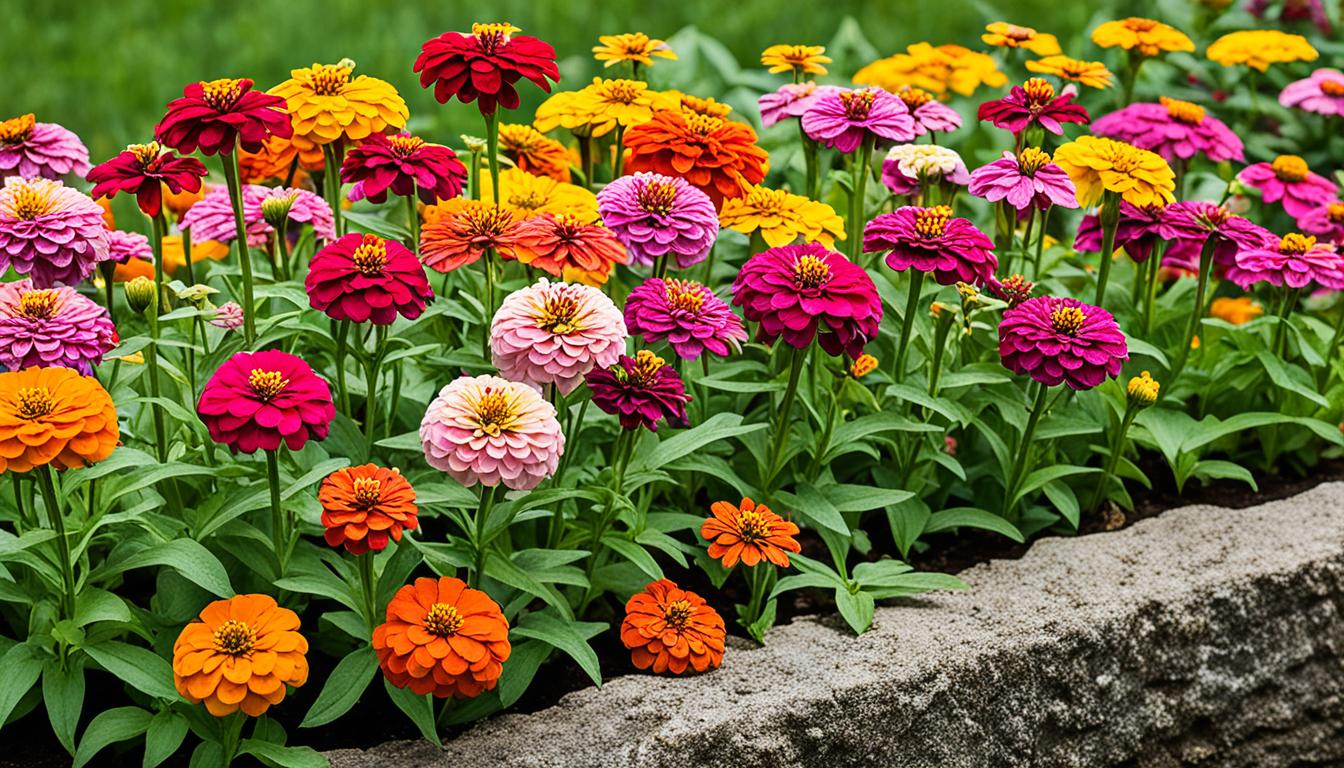I love exploring the world of zinnia plants. These annuals come in many shapes, sizes, and colors. They’re a favorite in gardens for their beauty and variety.
Zinnias can be tall and majestic or short and perfect for containers. They’re great for adding color to any garden. Whether you want tall plants for a cottage garden or shorter ones for containers, zinnias are a great choice.
These plants attract hummingbirds, bees, and butterflies with their bright flowers. In this guide, we’ll look at the different heights and growth habits of zinnias. We’ll help you pick the best ones for your garden and landscape.
Zinnia Plant Varieties and Their Heights
There are many zinnia varieties to pick from, each with its own height. From tall plants to compact ones, the height changes how your garden looks. The height of these flowers can make a big difference in your garden’s look.
Tall Zinnia Varieties
If you want a bold garden look, tall zinnias are great. They can grow up to 4 feet tall. This makes them perfect for the back of your garden or as a cut flower addition.
Some popular tall zinnias include Benary’s Giant, which can get up to 50 inches tall. Uproar Rose zinnias also grow 30 to 36 inches high.
Dwarf and Compact Zinnia Cultivars
For a shorter look, consider dwarf and compact zinnias. These plants are between 12 to 18 inches tall. They’re great for adding color to your garden’s edges.
Examples of these include the PanAmerican Seed Co. Zinnia marylandica, which grows up to 14 inches tall. The Profusion series zinnias reach 8 to 14 inches high.
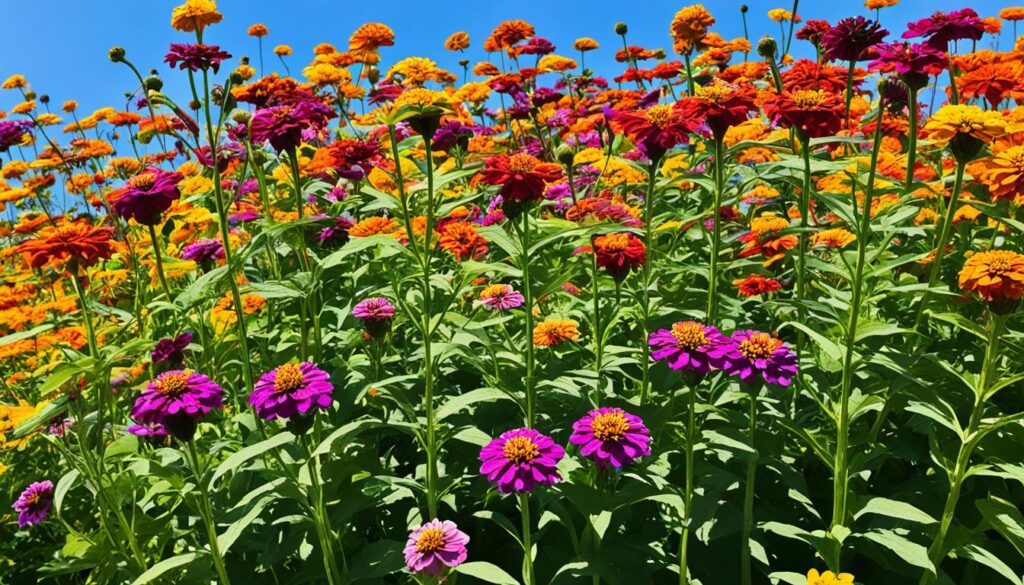
No matter the height you want, there’s a zinnia for your garden. Knowing the heights of zinnias helps you create a beautiful and balanced garden.
Factors Affecting Zinnia Growth Rate and Height
Sunlight Requirements
Zinnias are famous for their bright colors and lots of flowers. But, how much sunlight they get really affects their growth and height. They do best with 6-8 hours of direct sunlight every day.
This sunlight is key for their health, strong stems, and big flowers. Without enough zinnia sunlight requirements, they won’t grow well.
Zinnias can handle some shade, but they’ll have fewer flowers and might get sick without full sun. For the best sunlight for zinnia growth, pick a spot that gets lots of direct sunlight all day.
Soil Conditions
The type of soil is also important for zinnias. They like soil that drains well and is full of nutrients. The soil should be between pH 6.0 and 6.8 for the best results.
Zinnias can grow in poor soil, but adding compost or organic matter helps a lot. It makes them grow taller and have bigger flowers. It’s also important to prevent waterlogged soil, as zinnias don’t like it. This can cause diseases and slow growth.
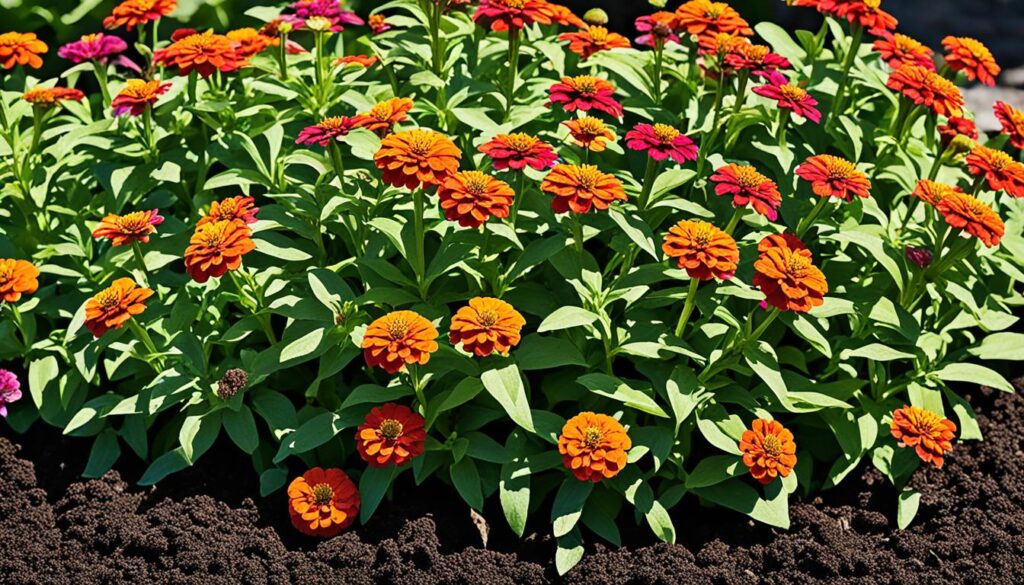
“Providing the right conditions for zinnias, including ample sunlight and well-draining soil, is the key to enjoying their full potential in the garden.”
Pruning and Pinching Zinnias for Height Control
Gardeners love the bright, long-lasting blooms of zinnias. They often ask how to control their height. With a bit of pinching and pruning, you can make your zinnia plants taller or shorter, based on what you like.
To get more branches and flowers from tall zinnias like the Benary’s Giant Series, pinch the top when they’re 8-12 inches tall. This makes the plants shorter and bushier. They might bloom a bit later, but you’ll get lots of flowers.
For regular zinnias that grow to 2.5 feet, cutting them back at 12 inches helps them grow fuller and bloom more. Giant zinnias, reaching up to 5 feet, should be pruned at 18 inches for more stems and flowers.
Harvesting zinnia blooms often keeps your plants short and blooming until the first frost. Make sure to use the “wiggle test” to check if the stems are strong enough for cutting.
Pruning and pinching zinnias helps control their height and shapes your garden’s look. With a little care, you can enjoy these bright, lasting flowers all season.
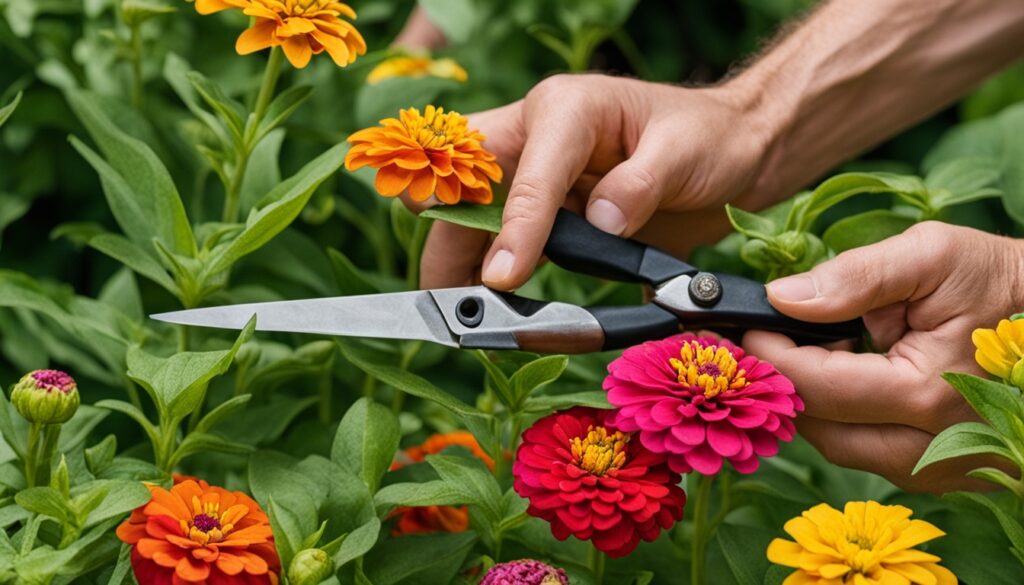
| Zinnia Variety | Recommended Pruning Height | Resulting Effect |
|---|---|---|
| Benary’s Giant Series | 8-12 inches | Shorter, bushier plants with more flowers |
| Standard Zinnias | 12 inches | More compact, bushy growth with increased blooming |
| Giant Zinnias | 18 inches | Promotes multiple stems and abundant flowers |
How Tall Do Zinnia Plants Grow?
Zinnia plants are known for their bright and varied blooms. Their height can change a lot, depending on the type. They can grow from 1 to 4 feet tall, with some reaching up to 4 feet. Dwarf and compact types usually grow between 12 to 18 inches.
The tall zinnia types, like Z. elegans, can stand out in the garden. They have big, colorful flowers that rise above other plants. These tall zinnias work well as a backdrop or in the garden’s center, adding height and drama.
On the other hand, the dwarf and compact zinnias, such as the Zahara™ series, are perfect for smaller spaces. They fit well along edges, borders, or in containers. Their smaller size adds charm to smaller gardens.
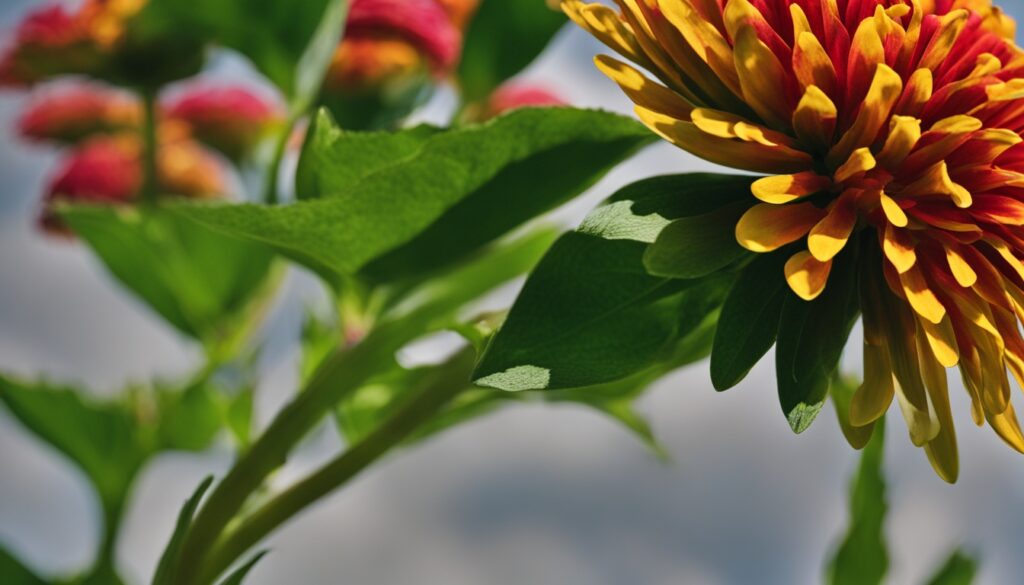
Zinnias grow fast, taking about 60 to 70 days to bloom from seed. They come in many colors and shapes, making them a favorite among gardeners and those who love cut flowers. Whether you pick a tall or dwarf variety, zinnias will brighten up your garden.
| Zinnia Variety | Typical Height |
|---|---|
| Z. elegans (Tall Zinnias) | 2 to 4 feet |
| Zahara™ Series (Dwarf Zinnias) | 8 to 12 inches |
| Profusion Series (Compact Zinnias) | 12 to 18 inches |
Zinnia plants can grow to different heights, giving gardeners many options. Whether you want a bold display or a low-growing arrangement, there’s a zinnia for you.
Zinnia Planting Depth and Spacing
Planting zinnias correctly is key for their growth and beautiful flowers. Whether indoors or outdoors, follow the right guidelines for success.
Sowing Zinnia Seeds Indoors
Start by sowing zinnia seeds indoors in pots with moist seed-starting mix. Do this 4 to 6 weeks before the last spring frost. Cover the seeds with about 1/4 inch of soil and keep them in a sunny window.
They will be ready to move outside when they are 4 inches tall. This method helps them get a head start.
Direct Sowing Zinnias Outdoors
Once it’s warm enough, you can plant zinnia seeds directly in your garden. Cover them with 1/4 inch of soil. They will start growing in 7-10 days.
Thin the seedlings to 8 to 24 inches apart when they are 2 inches tall. This lets them get enough air and grow well.
Zinnias love full sun, so pick a spot that gets at least 6 hours of sunlight daily. With proper planting and spacing, your zinnia garden will flourish, offering a colorful display all season.
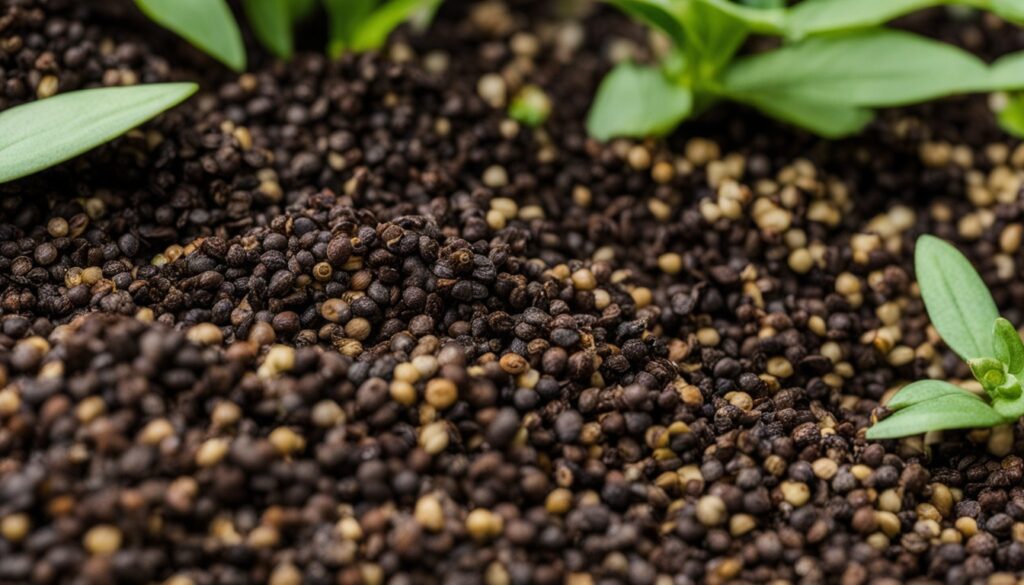
Zinnia Care Tips for Optimal Growth
Watering Needs
Watering zinnia plants is key for their growth. Young seedlings need soil that stays moist. Water them deeply a few times a week.
Once they grow, zinnias can survive short dry spells. But, they don’t like wet roots. So, avoid overwatering. Aim for about 1 inch of water per week, adjusting as needed.
Fertilizing Zinnias
Zinnias do well with a balanced fertilizer, like 5-5-5, when they start flowering. This is crucial for those in containers or raised beds. They use up soil nutrients fast.
Using a liquid fertilizer can also keep them blooming. Just follow the package instructions. Don’t overdo it, as too much fertilizer can make them focus on leaves instead of flowers.
With the right watering and fertilizing, your zinnias will thrive. They’ll give you a beautiful, colorful show all season.
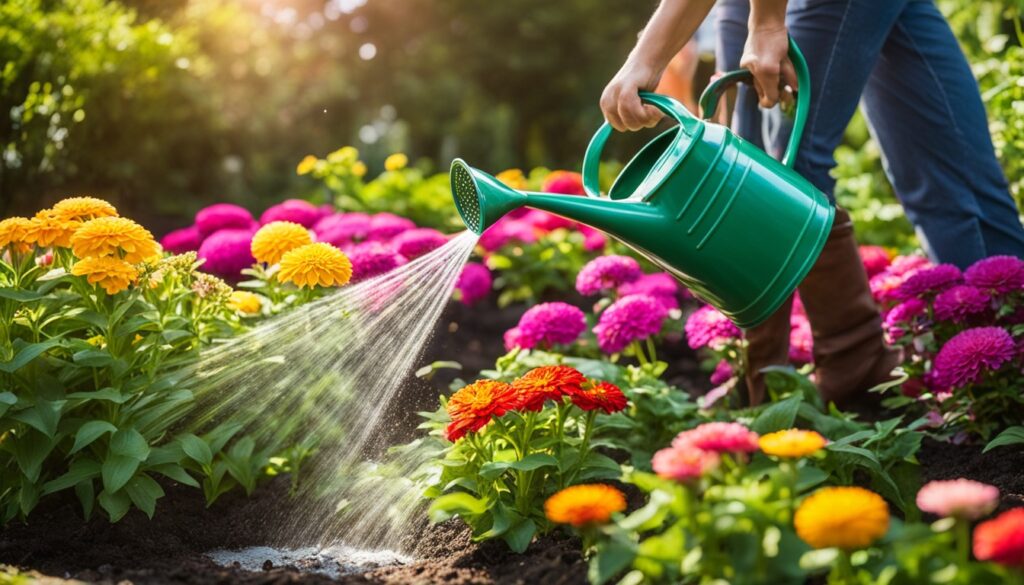
Conclusion
Zinnias are a versatile and eye-catching annual. They come in many heights, shapes, and colors. You can pick tall ones for the garden’s back or small ones for containers. These flowers add a bold splash of color to your landscape.
They grow well in full sun and need little care. This makes them perfect for both new and experienced gardeners. Zinnias attract pollinators and have long-lasting blooms, making them a must-have for any garden.
To make the most of zinnias, plant them from seed or add established plants to your garden. Follow the best practices for planting, watering, and fertilizing. This way, you’ll get a stunning display that brings joy and color all season.
FAQ
How tall do zinnia plants grow?
Zinnia plants can grow from 1 to 4 feet tall. The tall ones can reach up to 4 feet. Dwarf and compact types usually grow 12-18 inches tall.
What are the different types of zinnia plants and their heights?
Tall zinnias are great for the back of a garden or a cutting garden, reaching up to 4 feet. Shorter ones have a mounding look and are perfect for the front of the border, growing 12-18 inches tall.
What factors affect the growth rate and height of zinnia plants?
Zinnias grow well in a garden bed or a container with well-draining soil. They can grow in partial shade but will have fewer flowers and be more prone to disease. Full sun is best for them, promoting strong blooms and keeping the plant dry.
How can I control the height of my zinnia plants?
To make tall zinnias branch out and flower more, pinch the top when they’re young. This makes them shorter and may delay blooming. Since zinnias are annuals, you need to replant them every year.
How do I sow zinnia seeds to ensure optimal growth?
Start seeds indoors in pots with moist seed-starting mix 4 to 6 weeks before the last spring frost. For garden beds, wait for warm weather and cover the seeds with 1/4 inch of soil. They take 7-10 days to germinate.
How should I care for my zinnia plants to promote healthy growth?
Keep young zinnias moist by watering them a few times a week. Don’t overwater. Give them 5-5-5 fertilizer when they start flowering, especially in containers with soilless mix.
